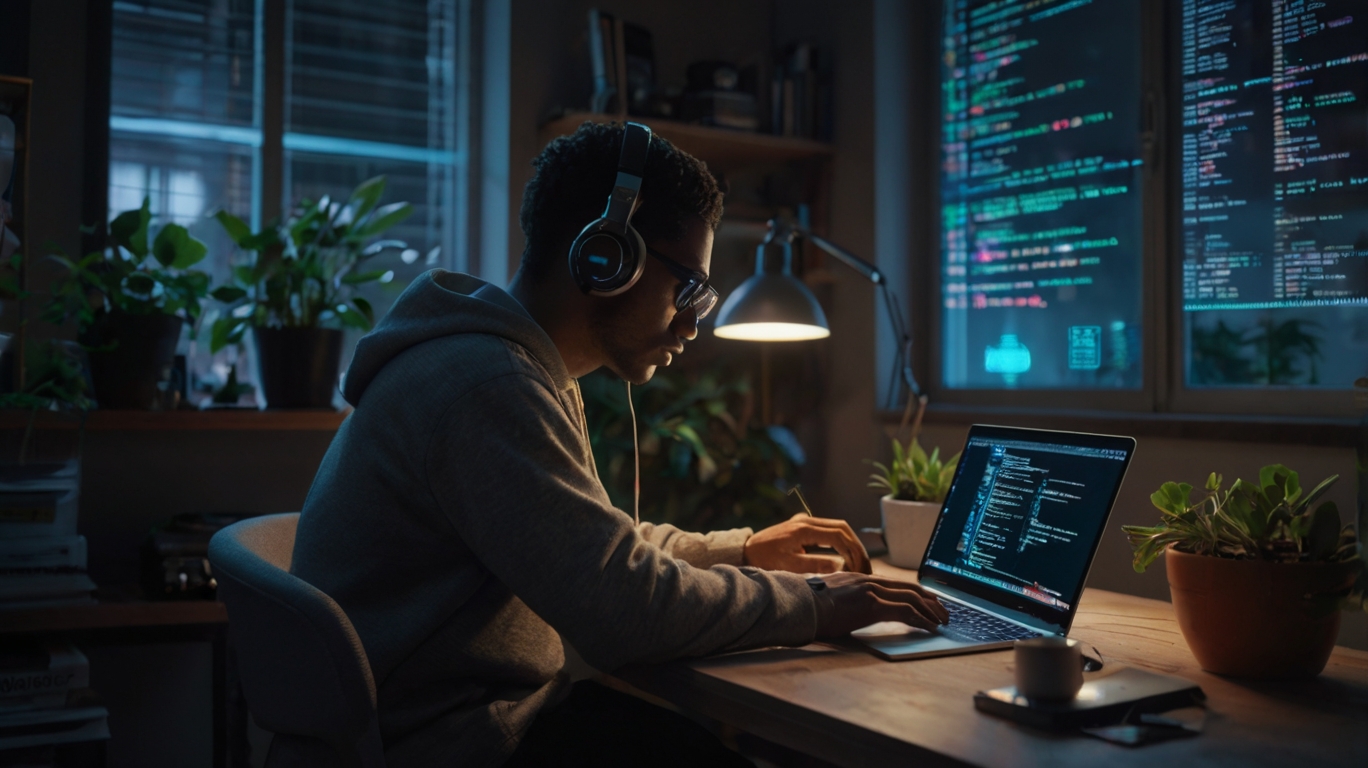Introduction to vibe coding in 2025.
Vibe coding. Coding does not look like the strict, difficult job it used to be in 2025. The days of learning to code by spending hours alone with a blank screen and silently pushing out late-night commits are long gone. Coding has evolved into a lifestyle, an art form, and a means of finding freedom and flow for many people. Greetings from the time of vibe coding.
So what exactly is vibe coding?
The programming language you use and the number of lines of code you produce in a day are relevant. It all comes down to your feelings when crafting. These days, developers are as concerned with their favorite desk plant, their lo-fi soundtrack, or the lighting in their office as they are about their tech stack. In addition to output, productivity is also evaluated by the energy and rhythm that drive the task. Balance is in; the grind is out.
 AI Automation, How ai automation works? 2025.
AI Automation, How ai automation works? 2025.
Coding is now easier than at any time through the development of AI copilots, user-friendly frameworks, and increasingly sophisticated dev tools. Full-stack apps are being shipped by teenagers using their iPads. Basic reasoning is being written in plain English by designers. Additionally, experienced developers are automating tedious processes to free up more time for teaching or creating passion projects.
The community is also changing. Real-time collaboration is being performed on digital platforms such as Twitter/X, Twitch, and Discord. In order to connect with a viewer that is mindful of the highs and lows of the development process, developers are live-streaming their side projects, sharing both successes and failures. It’s more “tech flow” and less “tech bro.”
The tone of coding in 2025 will be examined in this blog, including the tools and attitudes developers are adopting, the kinds of projects they are working on, and the digital culture that surrounds it all. You’ll realize that this new era is more about passion than perfection, regardless of your level of experience with code.
The Developer Mindset Today.
In 2025, there will be significant changes to the coding. The skill is now defined by manners, everyday life, and natural creativity rather than just being a technical aptitude. Developers are becoming more intentional and balanced, as opposed to the worn-out, caffeine-hungry coder who is always stressed for time.
From Hustle to Harmony.
The coding world of the early 2020s glorified hustle culture and worn the image of “No sleep, just code.” After years of squabbling with burnout stories, mental health crises, and the remote work revolution, developers began to question what they were missing.
In 2025, a modern developer puts balance over burnout. Productivity is now measured more carefully, but it is still significant. You may be creating fifty lines of error-free code, walking, and checking out before you eat while you’re having a terrific day at work. It’s sustainability, not laziness.
Embracing Emotional Intelligence.
A significant change in developer culture that is rarely noticed? The importance of soft skills has grown. Employers seek out programmers who can interact with people, communicate, work across cultural boundaries, and boost team spirit.
A significant change in developer culture that is rarely noticed? The importance of soft skills has grown. Employers seek out programmers who can interact with people, communicate, work across cultural boundaries, and boost team spirit.
Multi-Passionate, Multi-Skilled.
Instead of remaining in their usual positions as React developers or backend engineers, developers are pursuing alternative career options. Current endeavors like understanding AI ethics, podcasting, and starting independent apps all represent this tendency.
Why? Since curiosity spreads easily. As 2025 approaches, a developer’s priorities will change, shifting between design, code, music, art, and storytelling. Role distinctions are becoming more hazy, and it won’t be long. These days, we are known as “jack of all trades, master of none.” Why?
From Developer to Creator.
These days, developers can create using websites like GitHub, Gumroad, YouTube, and Substack. Coders’ responsibilities extend beyond problem-solving; they also include building audiences, imparting knowledge, and integrating their abilities into products.
This has given rise to a new category: the creator-developer. These are the individuals who sell VS Code themes, broadcast their coding sessions, make mini-courses, or post weekly dev logs on TikTok. The project, which is motivated by community and purpose, is not only about algorithms; it also includes code and content.
Remote by default, global by design.
Remote work is a deviation, but by 2025, it will be common. Developers are working from anywhere, from Berlin’s forest cabins and their beds to Bali’s co-working cafes. Teams expand time zones rather than restricting them.
This worldwide viewpoint has made it simpler for developers to collaborate, be globally conscious, and communicate smoothly in asynchronous situations. Instead of having a defined time for every hour from 9 to 5, it allows you greater freedom in creating a schedule that is more responsive to your energy level.
The Stack acknowledges Mental Health as a component.
It’s time to advance the idea that mental health is an essential component of the Christian faith. Discord channels provide counseling sessions, people are getting treatment funds, and YouTube is a common platform for talking about issues like burnout, anxiety, and ADHD.
The developer for 2025 pauses to reflect during difficult circumstances. People view vulnerability as a strength. Taking a break is a commitment to self-respect rather than self-interest.
